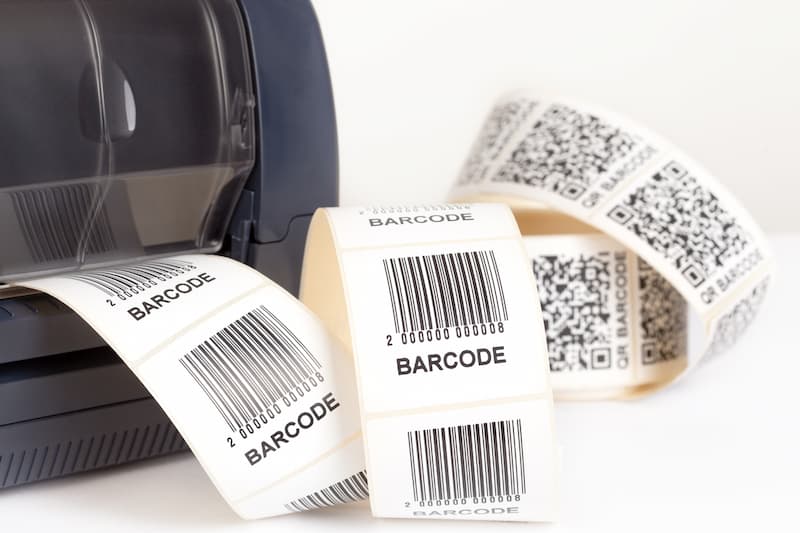For decades, barcode labels have been an essential element of most businesses, whether internal operations or external supply chain connections; designing high-quality barcode labels and correctly using them are essential for efficient business.

What to Look for When Designing Barcode Labels
Ensuring your barcode label printing is accurate and optimised to your business needs will provide much-needed confidence in your daily operations and the data you have about the status of your business. Unfortunately, most label design mistakes are related to the assumption that every label is equal; in truth, label design includes many unique elements that must be considered to produce the best results.
Incorrect Barcode Symbology
Barcode label symbology is a vital element to consider when picking the right label for your business; a common mistake is ignoring this area. Barcode symbology is a complex area with a rich collection of options for different applications. For example, UPC (universal product code) is the standard symbology most people are familiar with from commercial and retail environments. In contrast, code 39 is used for logistics tracking related to inventory and assets. Alternatively, intelligent edge solutions may need RFID labels in order to be the most effective.
Choosing the wrong symbology for your application will create problems for your long-term efficiency and even disrupt shipping fulfilment. Here are some examples of symbologies for specialist labels:
- Code 128: Used in shipping and logistics to encode large amounts of data, such as detailed product descriptions and shipping information. A highly beneficial choice for a barcoding system for warehouse operations.
- QR Code (Quick Response Code): Used in marketing and advertising to give customers access to websites, promotions, or other digital content.
- Data Matrix: Used in manufacturing and supply chain management to track products, equipment, and assets.
- EAN (European Article Numbering): Used in Europe to identify products and track sales, similar to UPC.
- ITF (Interleaved two of five: Used in logistics and transportation to track packages and shipments.
- GS1-128: Used in supply chain management to encode global trade item numbers and other product information.
- Codabar: Used in libraries, blood banks, lab labels and other specialised industries to identify items and track inventory.
- MaxiCode: Used in shipping and logistics to encode complex data, such as shipping addresses and delivery information.
For international labels, each nation may have a different set of rules related to barcode symbologies (except the initial UPC example); this should be investigated before printing your labels to ensure no disruptions on your asset’s journey.

Ensure Your Label Is High Contrast
To promote efficient and accurate results regarding your business’s barcode labels, they must be easily read by a mobile barcode scanner with no delays or errors. The encoded data should be printed in high contrast compared to the background to have a reliable, readable barcode label. This is why most labels use black on white as the highest contrasting choices, but other choices, such as red on white or black on other bright colours like yellow, can be chosen.
Many label designs will employ a quiet zone surrounding the label to enhance this beneficial contrast. Readers familiar with printing will be aware of the trim safe zone; for label design, it is known as the quiet zone. The quiet zone is a blank area surrounding the symbology to allow the scanner to define the extent of the encoded data. For example, the quiet zone around code 39 is ten times the width of the narrowest end of the symbology.
Including barcode font on your labels will be a suitable backup. Generally, 2D barcode labels will include a selection of numbers underneath the encoded area. These HRI (human readable interpretations) relay the encoded value of the label and can be used to input the data manually should part of the label become damaged.
The aesthetics of your packaging is important, but when it infringes on the contrast requirements and the quiet zone of your labels, it will cause issues for your inventory management later in life.

Unsuitable Label Materials
Another common mistake is assuming that labels always need to be printed onto thin adhesive paper, there are many choices when it comes to label materials, and some work environments require more than just paper. There are extreme work environments that will need more substantial materials, such as medical lab testing and automotive manufacturing.
For example, slide labels can survive -40°C to +150°C for extended periods. These labels are designed to provide crisp and clear sample identification even after long storage periods in medical freezers. You’ll find slide labels commonly used in pathology, cytology, genetics, microbiology and biochemistry. Additionally, Cryogenic labels need to resist temperatures as low as -196°C. Further, the repeated freeze and thaw cycles combined with other harsh processes will, at the very least, put your label’s solvent compatibility to the test. Nitrogen liquid and vapour can be a hazard for labels also. That’s why cryogenic labels are designed to avoid delamination during freezing effectively.
The automotive industry requires substantially strong materials for their labels as they must withstand exposure to solvents, chemicals and oil-based products. This is true for the shipping of components and the long-term use by a purchased customer. They must also be highly adhesive to prevent the label from being lost. Automotive labels in this industry are sometimes made with metal or plastic to ensure maximum longevity.

How Do Unreliable Labels Harm Businesses?
Your choice needs to be accurate and durable to create a label that will be reliable for your company. There are many ways that unreliable labels will negatively affect your company; here are a couple of examples:
Internal inventory and asset record keeping will be significantly hindered if your team is delayed in scanning appropriate labels. Inaccurate reports could be related to damaged or corrupted labels, leading to inaccurate scanning. The efficiency of your storage or workspace will be harmed as your team needs to compensate for failing labels.
When working with ineffective labels, lost revenue and increased costs are real risks. This will be found in multiple areas, such as decreasing customers, unnecessary ordering, or inaccurate stock results.
For example, an online customer attempting to purchase an out-of-stock item due to incorrect stock-taking will create a powerfully negative impression of your business and significantly decrease the chance that they will choose you over your competitors again. Additionally, unreadable barcode labels on products could be sold at incorrect prices, or customers could be sent the wrong item, requiring you to pay for the item to be returned and the correct one sent out.
This previous eCommerce example can be extrapolated to packaging labels required for many business-to-business sales within supply chains. Some examples include automotive component manufacturing, scientific medical samples and retail store stock to reveal the immense harm unreliable labelling can have on your business.
Barcode Labels and Printers at GSM Barcoding
At GSM Barcoding, we specialise in providing label design and asset label printing services for various businesses across the UK. We also stock a range of high-quality Zebra printers that are perfect for creating updated versions of your chosen label in the future. Contact us to discover how we can help improve your business’s labels.


















